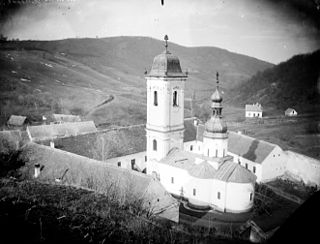
The Velika Remeta Monastery is a Serbian Orthodox monastery located in the village of Velika Remeta on the mountain Fruška Gora in northern Serbia. It is one of several monasteries of Fruška Gora. Traditionally, its founding is linked to King Stefan Dragutin. The earliest historical records about the monastery date to 1562. It was declared Monument of Culture of Exceptional Importance in 1990, and it is protected by the Republic of Serbia.

The Vrdnik-Ravanica Monastery, also known as Little Ravanica, is a Serbian Orthodox monastery in Vrdnik in the Fruška Gora mountains in the northern Serbia, in the province of Vojvodina. The exact date of its founding is unknown. The records indicate that the church was built at the time of Metropolitan Serafim Jovanović, in the second half of the 16th century. The present church in the monastery was constructed in the period from 1801 to 1811. The icons on the altar screen and the vaults were painted by Dimitrije Avramović in 1853.

The Jazak Monastery is a Serb Orthodox monastery on the Fruška Gora mountain in the northern Serbia, in the province of Vojvodina. The monastery was founded in 1736. The icons on the baroque iconostasis were painted in 1769 by Dimitrije Bačević and the carved woodwork was attributed to engraver Marko Vujatović. An overall reconstruction of the monastery was carried out from 1926 to 1930.

The Novo Hopovo Monastery is a Serb Orthodox monastery on the Fruška Gora mountain in northern Serbia, in the province of Vojvodina. According to tradition, the monastery was built by the Despots of the House of Branković. The first written mention of the monastery was made in 1451, and the latest mention of the monastery dates back to 1641. The extant church was erected in 1576 and the bell-tower with the small St. Stephen's Chapel upstairs was built between 1751 and 1758. The monastic residences were constructed in several stages, from 1728 until 1771. The icons were painted in 1776 by Teodor Kračun.

The Privina Glava Monastery is a Serb Orthodox monastery on the Fruška Gora mountain in northern Serbia, in the province of Vojvodina. According to legend, Privina Glava was founded by a feudal lord whose name was Priba/Priva, in the 12th century while another attribution is the 15th century Srem despots of the Branković family. The earliest historical records about the monastery are dated in 1566/1567. The icons in the altar screen were painted by Andrej Šaltist in 1786, and the wall paintings by Kuzman Kolarić in 1791.

The Rakovac Monastery is a Serb Orthodox monastery on the Fruška Gora mountain in the northern Serbian province of Vojvodina. The monastery of Rakovac with its church dedicated to the Holy Healers Cosmas and Damian, as tradition has it, was founded by Raka Milošević, Chief Chamberlain to Despot Jovan Branković, according to a legend written in 1704. The legend states that Raka erected the monastery in 1498. The earliest historical records mentioning the monastery are dated to 1545–1546. Inside, there are fragments of the frescoes on the walls which date from the first half of the 16th century. The baroque bell-tower was adjoined in 1735, and the residential building gained its final, three-range shape in 1771. The icons on the baroque iconostasis were painted by Vasa Ostojić in 1763, while the wall paintings in the refectory are 1768 works of Amvrosije Janković.

The Šišatovac Monastery is a Serb Orthodox monastery situated on the Fruška Gora mountain in the northern Serbia, in the province of Vojvodina. The foundation of the monastery is ascribed to the refugee monks from the Serbian monastery of Žiča. The first reliable facts illustrating the life of the monastery date back to the mid 16th century. A great benefactor of Šišatovac Monastery was Sekula Vitković (1687–1754) who in 1731 was appointed regimental commander of the Danube Serbian Militia. The building dates from the 16th century. It was through a donation by Vikentije Popović-Hadžilovac, the Bishop of Vršac, that the new, extant church building was constructed in 1778. The iconostasis is the work of the famed Baroque painter Grigorije Davidović-Obšić.
Marek Kulič is a Czech former professional footballer who played as a forward. He played for FC Hradec Králové, AFK Atlantic Lázně Bohdaneč, FK Drnovice, FK Marila Příbram from 1999 to 2003, SK Dynamo České Budějovice from 2003 to 2005, and in FK Mladá Boleslav from 2005 to 2007. After two years in Sparta Prague he transferred back to FK Mladá Boleslav in June 2009, where he served as captain. He made 12 appearances for the Czech Republic national team scoring 3 goals.
Slavko Kulić is a Croatian scientist and economist concerned with the sociology of international relations.
Zoran Kulić is a Serbian retired footballer.
Kulić is South Slavic surname. Notable people with the surname include:
The Dinka are a East African ethnic group.
Kulič is a village in the municipality of Smederevo, Serbia. The settlement is in the period 1959–1997. year was part of the settlement Šalinac, before 1959 it was an independent settlement. Officially recognized as an independent settlement 2011. According to the 2011 census, the village has a population of 232 people.
Kulič is a village in the municipality of Smederevo, Serbia.
Kulich is a village in Kurdistan Province, Iran.

Elita, formerly known as Zadruga, is a Serbian reality TV series broadcasting on Pink TV, as a successor of the Farm reality TV series. The first season started on 6 September 2017.
Kulich is surname. Notable people with the surname include:
This page is based on this
Wikipedia article Text is available under the
CC BY-SA 4.0 license; additional terms may apply.
Images, videos and audio are available under their respective licenses.







